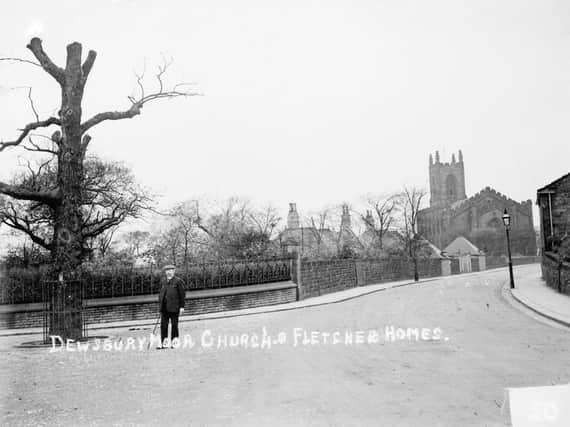Nostalgia with Margaret Watson: Dewsbury Moor rich in history and with links to famous people


Margaret Watson writes: Many villages have had entire books written about them including, Thornhill Lees, Thornhill, Chickenley, Batley Carr and Earlsheaton, but sadly not Dewsbury Moor.
And, more should be written about this part of Dewsbury which is rich in history and has links with a number of famous people, including John Wesley, who preached there.
Advertisement
Hide AdAdvertisement
Hide AdCharlotte Bronte and her younger sister, Anne, also taught there, and Nobel Prize winner Sir Owen Richardson, was born there in 1879.
He attended St John’s C of E School, just across the road from the church, and later Batley Grammar School.
He would no doubt have gone to Wheelwright Grammar School in Dewsbury, which was only a few minutes’ walk from his home, but that school had not yet been built.
Sir Owen was awarded the Nobel Prize for Physics in 1928, and his discovery of the law which bears his name – Richardson’s Law – made possible the rapid development of radio and telephony, as well as television and ex-ray technology.
Advertisement
Hide AdAdvertisement
Hide AdHis father, Joshua Henry Richardson, owned a woollen firm in the town, and the family lived in nearby Blenheim Terrace.
Sadly, the memory of this remarkable man is long forgotten and one wonders why the school in Dewsbury Moor which he attended as a little boy does not have a blue plaque erected upon it.
The photograph above shows just a small part of Boothroyd Lane leading to Dewsbury Moor, but this little area on its own, tells a fascinating story.
For St John’s Church was the church which Charlotte Bronte attended while teaching at Healds House in Healds Road, where Miss Margaret Wooler ran a private school for girls.
Advertisement
Hide AdAdvertisement
Hide AdCharlotte’s younger sister Anne, was also a pupil at the school, and she also taught the children of poor families living nearby, who otherwise would have received no education whatsoever.
She also resided in a little cottage at the top of Dewsbury Moor, which unfortunately was demolished some years ago.
The two sisters used to walk down to Dewsbury to attend services at Dewsbury Parish Church where her father Patrick Bronte had been curate some years earlier.
St John’s Churchyard is also rich in history, containing as it does, the graves of a number of important people, including that of Dr Charles Turner Thackray, who died in 1833, aged 38.
Advertisement
Hide AdAdvertisement
Hide AdDr Thackray was recognised as a pioneer in the fields of industrial medicine and haematology, and an early campaigner for the protection of children in mines and factories.
The epitaph on his grave reads: “After a life spent in the active practices of that profession of which he was a distinguished ornament, he fell martyr to his exertions.”
The churchyard at St John’s was also the original burial ground for those who died in the Union Workhouse, which was situated where the Dewsbury and District Hospital now stands.
Next to the church stand six historic cottages known as the Fletcher Homes, which were built in 1900 to house the elderly poor of Dewsbury.
Advertisement
Hide AdAdvertisement
Hide AdThe houses, which are still there, were built in the grounds of Crow Nest Park and bequeathed in memory of Mr Alfred Fletcher JP by his wife and daughter.
Mrs Fletcher had stipulated the cottages could only be occupied by people who had been resident in Dewsbury no less than 20 years and had to be aged 60 or upwards.
When the homes were officially opened, Alderman Joe Haley, said that in the history of Dewsbury there had never been a case where a gift to the town had been so popular and more in sympathy with the general wishes of the people.
He felt there was nothing which could have commended itself better to the inhabitants of Dewsbury than the gift of dwellings to those who had got past the meridian of life in which to spend their last days in comfort and peace.
Advertisement
Hide AdAdvertisement
Hide AdThe Mayor, Alderman Beattie, presented Mrs Fletcher and her daughter with a golden key bearing the arms of the borough with which to open the first home. In doing so he said: “What could have been more thoughtful than Mrs Fletcher trying to soothe the eve of life for those honest and industrious people who had been less prosperous than herself?”
He said the town of Dewsbury was under a deep obligation to them for providing such handsome homes.
Miss Fletcher said she believed nothing could have been more in keeping with her father’s feelings than the erection of the houses.
She trusted that under God’s blessing they would be the means of much help and comfort to many weary hearts for many generations to come.
Advertisement
Hide AdAdvertisement
Hide AdThe first occupiers of the cottages were: first block – Mr and Mrs Barker, Savile Town, and Mr and Mrs Paul Wilson, Heckmondwike Road, Dewsbury Moor; middle block – Mrs Ellis and daughter, of Willans Road, who formerly lived in service with Mrs Hague in the lodge in Crow Nest Park, and Mr and Mrs J Hemingway, of Ashworth Road.
The photograph above shows a view of St John’s Church, and the Fletcher Homes in Boothroyd Lane, both of which are still standing. Crow Nest Park is just over the wall.
I walk past St John’s Church many times and I am always delighted to see that, not only is it still open but also very active.
Next week I will write further on the Fletcher family, who were Quakers, and attended the Friends Meeting House in Bradford Road, which closed some years ago.
The building is still there and is now used by Dewsbury Arts Group.